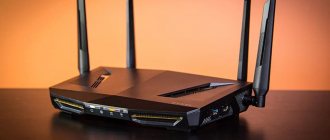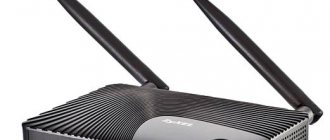Author of the article
Mikhail Romanovsky
Computer repair engineer, technical support specialist
Even the most budget wireless routers can be fraught with surprises. Zyxel Keenetic Start is just one of these. It's easy to set up, has all the modern features and sacrifices very little to be cheap. Here you can watch IPTV, there is support for a large number of connection protocols and excellent firmware that allows you to quickly change any device parameters. We'll talk about setting up the Keenetic Start router, its capabilities and appearance in this article.
Indicators and connectors
On the back wall there is a completely standard set of connectors and buttons. From left to right here are:
- factory reset button.
- 5 already mentioned network ports.
- power connector.
- on/off button.
On the front are indicators of various device states. The first, Power, shows the power status. Those marked with numbers from 0 to 5 indicate the occupancy of the LAN and WAN ports. The Wi-Fi symbol indicator indicates the presence of a wireless connection. The last globe icon is responsible for demonstrating the Internet connection.
Router configuration and appearance
The router's equipment is minimal: a small network cable, documentation and a power supply. All inscriptions on the device body are made in Russian. The device is available for wall mounting. In a convenient place is the WPS activation key, a function that allows you to easily and quickly connect Wi-Fi devices to the router, without using an encryption key.
In appearance, the router in question is very similar to its older brother (Keenetic 4GII). It only differs in the absence of USB ports and the presence of only one 2dBi antenna.
The device is quite compact (140x110x30 mm). Its weight is only 180 grams.
On the top side there is a trademark of the manufacturer, a WPS button to enable an automatic secure Wi-Fi connection, and LED indicators for power, the inclusion of a wireless Wi-Fi module, the presence of an Internet connection and connection to lan ports.
All ports and connectors are located on the back of the router.
Connection
To connect to the Internet, just insert the cable installed by your provider into your home into the WAN port, and the patch cord that comes with the router into any LAN port on the device. In addition, to connect the Keenetic Start router to the mains, you need to insert the power cord into the appropriate socket and press the power button. Depending on the type of connection, the router will be configured either automatically, or according to instructions from the provider, or by a technical support representative.
We connect two devices: a computer and Zyxel Keenetic Start
To configure, you can use a desktop computer or laptop (notebook). First of all, create a communication channel between the Zyxel router and the laptop - use the cord from the kit. Connect the two ends to the network connectors of the PC (connector on the side panels of the case or the back) and the router (any yellow output).
Fully insert the provider cord that comes from the entrance or the modem in the hallway into the Internet socket. And of course, turn on the gadget itself to distribute Wi-Fi.
Connect your PC and router using the included power cord
Login to router settings
Immediately after connection, a pre-configuration wizard appears on the user’s computer screen. To ensure that the default connection parameters (point name and password, for example) are not used, the captive portal service notification automatically redirects any requests to the initial setup page. To launch the NetFriend Connection Setup Wizard, there is an "Open Network Login Page" button shown in this screenshot.
If the wizard does not start, you can find it yourself by entering the address 192.168.1.1 in the address bar of your browser. To log in, you will need a login and password, which should be admin in both cases, if the provider has not made any preliminary settings. In some firmware versions, the password is 1234, but such devices are now rare on the market. Alternatively, if none of the options are suitable, you can look at the bottom cover of the router - there may be a sticker with these parameters.
The first screen is to select a setup method. There are two buttons here - “Quick setup” and “Web configurator”. The first one will configure the router automatically, the second one will configure it manually. Let's talk about the differences in these two methods in more detail.
Resetting the router
In order to reset the router, you must perform the following steps:
- wait until the device is fully loaded;
- Press and hold the “RESET” button on the router until the power indicator begins to blink rapidly. Typically the button should be held for about 10 seconds;
- release the “RESET” button.
After this, the router's power indicator will start blinking and then the router's settings will be reset to factory settings (default settings).
Automatic setup
The easiest way. If the provider assigns the IP address via DHCP and does not require binding a MAC address, the connection will be established without user intervention, you just need to wait a few minutes. If the IP is static and unknown or you need to find out the MAC address, the easiest way to do this is through the command line.
First you need to run it: Win + R – cmd – Enter:
After that, enter the command ipconfig /all and look at the output lines marked in red in the following picture:
These are the MAC addresses of network adapters. You need to enter the one that is registered with the provider. If the user does not know which one, it is better to ask the support service.
After all these manipulations, setting up Zyxel Keenetic Start will take place without the user’s participation, and in the end he will receive a completely ready-made Internet connection.
Functional features
The device belongs to the budget class, so its capabilities are not comparable to flagship models. A big plus is the presence of MIMO technology, which significantly expands the network coverage distance. An additional advantage is support for the modern IPv6 network protocol, which is not often found on inexpensive routers.
Additional functions:
- DHCP is a system protocol that ensures automatic sending of data with settings and available IP addresses to connected devices;
- IGMP proxy - dynamic routing that allows different Internet routers to exchange information;
- Dynamic DNS is a network protocol responsible for the timely transfer of local network data to the DNS server;
- Firewall or firewall guarantees a high level of security for the wireless network;
- NAT technology is designed to translate IP addresses for easier management;
- the SPI mechanism is used to provide protection against hacker attacks;
- filtering by MAC, IP or TCP/UDP automatically sorts devices, opening or closing access to the local network.
The Keenetic Start KN-1111 router is an excellent device that can provide a standard apartment or small business office with a high-speed broadband Internet connection. Small functionality is covered by high-quality assembly, simple Wi-Fi setup and fast Internet.
Manual setting
The first step in this instruction is also setting the MAC address. After this, you need to select the IP protocol configuration. The choice of the desired option here is also influenced by how the provider assigns a network address to the user within its network. If via DHCP, then you need to select “Automatic”. If the address is static and it is known, select “Manual” and fill in the following three lines:
- IP address: static IP obtained from the provider.
- Subnet mask: default value – 255.255.255.0
- Default Gateway: IP-dependent parameter, basically repeats the address specified in the first paragraph, differing in the last digit - it will be either “0” or “1”.
It is not necessary to specify DNS servers. They are edited in special cases - for example, if the user wants to pass traffic through Google servers for greater security or block certain types of advertising in the browser.
After this, just click the “Go online” button on the screen that summarizes all the settings made and, if nothing else interferes with the connection, the user will have a connection to the network.
In addition, there is configuration exclusively through the web interface if, for example, the connection is made via the PPPoE protocol and preliminary configuration of Keenetic Start is required. To do this, go to the web configurator on one of the first screens. After this, a browser page will open that will look something like this.
As you can see, each type of protocol is placed in a separate tab. Configuration of PPPoE or IPoE will occur using the parameters provided by the provider.
Conclusion
The advantages of Kinetic Start are determined by the following indicators:
- built-in service "DNS.Yandex" (ensures the security of connected devices when working on the network);
- network filter;
- ability to select a protocol;
- availability of SkyDNS (for parental control).
The disadvantages of this model include the fact that there is no USB port. This circumstance limits the functionality of the router (precludes the possibility of using a printer).
We hope we answered all your questions! If something is unclear, or we have not given a complete review, do not hesitate to write! Our friendly admins and authors are always happy to chat!
Setting up via mobile application
The Play Market for Android and the App Store for iOS have the My.Keenetic branded application. It is supported by all router models, but for more modern devices there is also more modern software for smartphones. Setting up the Zyxel Keenetic Start router is possible through such an application and is no different from previous types. First you need to install My.Keenetic on your smartphone by finding it in the appropriate store. Zyxel Keenetic Start does not have a QR code for downloading it, as in modern models.
Setting up a router begins with connecting to its access point. Then in the application you can click the “OK, Wi-Fi connected” button on the start screen.
After this, another window will appear, in which a “Run NetFrient Setup Wizard” button with an image of an animal will be displayed.
By clicking on it, a slightly simplified visual wizard will launch, completely repeating the functions of its desktop counterpart. All the steps described for manual and automatic configuration above in the article are applicable here.
How to use Zyxel Keenetic Start as a Wi-Fi signal repeater
This model can take on a secondary role - being only a repeater of the Wi-Fi signal that you have already configured on another router (we will call it the main device). If this is your case, follow these instructions:
- Open the panel with the gear at the bottom. In the section with modes, mark the amplifier and click on the “Apply” button to proceed to the settings.
Set Amplifier as Mode
- Confirm mode switching.
- The device will restart - on the platform you will see short instructions for connecting the main router and Keenetic Start. According to it, you need to press the Wi-Fi button on the top panel of the repeater, and then press WPS on the main device. The gadgets themselves will communicate with each other. Keenetic Start will copy the network information. His IP address will change - the main router will come up with a new one for him. You will need to log into the web platform at a new address.
Follow the instructions described in the web shell to connect the main router to the repeater
Wi-Fi connection and settings
The My.Keenetic program is quite functional and easy to use. All connection parameters are collected in menu items, which are displayed in a list on the left side of the screen. Basic setup can be done in the “Wireless ISP” menu. There may be either two tabs responsible for different frequency ranges, or one. In the case of Keenetic Start, there is only one band - 2.4 GHz.
The switch at the very top of the tab is responsible for the state of the access point and its visibility by external devices. Below it is a drop-down list with work schedule settings. You can choose to have the access point inactive at night or when no one is in the house.
Below are the connection parameters, the name of the network (its SSID) and the type of protection. It is not recommended to set the latter to the “No protection” position; it is better to enable WPS and set a password combination. Even lower are the parameters for obtaining an IP address and additional IP settings. For some providers, for example, Beeline or Rostelecom, it is not recommended to change them.
The menu items belonging to the “My Networks and Wi-Fi” group also have several interesting settings. For example, in the “Guest Network” sub-item you can enable an access point that is very limited in its functionality and will not be protected by a password. You can make it significantly slower than usual and set connection time limits. In the “Device List” sub-item, you can ban those devices whose connection to a wireless connection is undesirable. This is useful, for example, when restricting Internet access to children.
Zyxel Keenetic Start: about the appearance of the model, cost and other features
Zyxel Keenetic Start is the first option in the Start line of routers from this company. There are also second and third versions - more advanced. Let's look at the router from all sides. The first thing that catches your eye is the large button with the image of “Wi-Fi” on the top panel of the case. It performs the WPS function - a simple and quick connection of devices to an access point if, for example, you have forgotten the password for it.
There is a round button on the top of the device that helps connect devices to the network without entering a password
There are several light bulbs (LEDs) along the front edge. From them you can determine the status of a particular router function, keys or outputs (ports). Speaking of ports, they are all located at the back: 4 local yellow ones for connecting computers and other devices and 1 for the Internet. There is also a power button and a key to reset the device to factory settings.
On the back panel of the router there are 4 local outputs and 1 for the provider cable
The model has only one antenna. From here the immediate conclusion is that it is enough to cover only a small room, for example, a one-room apartment. But the device is budget-friendly - 1,650 rubles according to Yandex.Market.
In addition to the device itself, the manufacturer puts an Ethernet cord in the box - with the help of it we will connect the router to your computer for setup. The kit also includes a charging device and instructions for use.
Table: main characteristics of the Start model
| Parameter | Meaning |
| CPU | RT5350 350 MHz |
| RAM | 32 MB SDRAM |
| Flash memory | 4 MB |
| Antenna | 2 dBi |
| Ethernet ports | 5 x 100 Mbit/s |
| Access point, amplifier, adapter modes | Yes |
| Wi-Fi network speed 2.4 GHz, Mbit/s | 150 |
| IPoE/PPPoE routing, Mbit/s | 90 |
| Routing L2TP/PPTP, Mbit/s | 60 |
Setting up IPTV
To activate this feature, you first need to make sure that the latest version of the router software is installed. If not, read the “Updating Firmware” section of the article.
The router does not have a built-in set-top box, and its processor also does not support such a function at the hardware level. Therefore, to configure, you must first connect the digital receiver provided by the provider to one of the LAN ports.
After this, you need to go to the WAN item of the modem configuration, find “Select ports” and click on the connector with the connected set-top box. Two more input fields will open - IP and password, where you need to enter information from the provider. It is worth noting that IPTV from Rostelecom has the simplest setup.
How to make an access point and put a new password on it
The Wi-Fi network (access point) is created automatically in the settings. Its name is standard - with the name of the manufacturer. Not everyone likes it. In addition, there is not always a password on the network, and even if there is, it is a weak one. How to set new, unique data for your network:
- We open the central section at the bottom for Wi-Fi. In the first menu, we first activate the network (check the box).
- We set a suitable name in English (you can write Russian words, but also only in English letters, insert numbers and dashes with underlining).
- The most important thing is to install WPA2 PSK protection. Below in the key field we enter the most complex password. Write it down separately in your notebook.
- What else can be changed is to indicate the country and the combined bgn network standard. Save everything at the end.
In the access point, enter the network name and password
Change Password
Editing the security combination has already been described above; here we will show you how to change the administrator password. To do this, you need to go to the “System” item on the main page, and then – “Users”. If the router does not have a guest network configured, only admin will be displayed here. The default password is also admin. You need to click on it, after which a menu with changing the password will appear:
It is recommended that you not only enter it, but also write it down in a safe place - for example, in your phone notes or on adhesive paper, which you can then stick on the router itself.
By clicking the “Apply” button, the password will be changed to a new one.
Let’s move on to the computer: after connecting the router, we’ll configure the PC’s network card
The computer itself should recognize that you connected it to the router via a cord. In rare cases, this does not happen if the laptop’s network card is not configured as needed. To enable automatic recognition, follow these short instructions:
- Expand “Start”, find the “System” folder, and in it “Control Panel”. If you have Windows 7, look for the panel immediately in the right list of sections.
- On the panel, go to the “Network Center” block.
- Click on “Change adapter settings”.
- Call the context menu of the Ethernet adapter or “Local connection”. Click on "Properties".
- Select IPv4 protocol. Go to its properties. Set automatic retrieval of DNS and IP. Save your changes.
Set the value to “Receive data automatically”
Repeater mode
The signal amplifier is a useful feature in the case of Keenetic Start. It only has one antenna and the signal in some parts of the house may fade or even disappear. Therefore, you can use the router itself as a signal repeater for another, more powerful device. To do this, you need to enter the setup program, select the “Mode” tab and set the switch to the “Amplifier” position.
Model overview
The Start Keenetic router operates from a regular 220 V network, is completely autonomous, is easy to set up and does not require maintenance.
The model has all the necessary functionality for connecting to the Internet. But its main difference from more expensive models is reliability.
Keenetic is designed to ensure uninterrupted interaction of all electronic devices at home with the “global network”. The functionality allows you to configure several types of connection - Link DUO - to the provider:
- Directly to the Internet.
- Through local resources of providers, the so-called regional network.
Network types
The Start Keenetic router also creates two types of networks: home and guest. The following devices are connected to the home:
- Receiver for IPTV.
- Four computers via LAN (wired).
- Smartphones, laptops and IP cameras via wireless connection. The quantity is set by the user.
The guest network is configured for a wireless connection to the Start Keenetic router, bypassing the home network, thus guaranteeing the safety of personal data.
The first model of the Start Keenetic router, unfortunately, does not have the ability to connect several providers and add a backup 3/4G channel. There is also no possibility of connecting an external drive and, as a result, installing a torrent client. There is no DLNA server to manage media files from the phone.
Connection types
The main purpose of Start Keenetic is to provide access to the Internet via a line dedicated by the provider. The model works with various connection types:
- VPN (PPTP and L2TP).
- VLAN 802.1Q.
- PPPoE.
- IPv4/IPv6.
- 802.1X.
The MIPS processor provides the ability to work with file sharing services from several devices at once at speeds with a total volume of up to 80 MB/s.
The Wi-Fi wireless connection operates using the latest 802.11n protocol, which provides data transfer at speeds of up to 150 Mb/s. For ease of authorization, interaction with WPS standard devices is built-in.
Thus, connecting a new device takes a few seconds.
Additional functionality
The general package of Keenetic functions includes a free Yandex.DNS service that protects your PC or smartphone from malicious sites and resources for adults. The built-in Internet filter also blocks the download of infected files and warns about untrustworthy pages.
To work with devices over a local network, a managed switch is built into the router. It connects computers, receivers and other devices at speeds of 10/100 Mbit/s. To simplify the user's work, Start Keenetic is also equipped with a DHCP server that automatically issues each new device an IP address.
If there are children in the house, the parental control feature provided by the SkyDNS service will come in handy. With the help of this service, categories of sites accessible to the child are independently selected and filters are created to limit it.
With Start Keenetic and DynDNS and NO-IP clients, it is possible to gain remote access to your router. And also create file and web servers and share them with friends. In addition, use the server to monitor your home online by installing a network camera.
In general, these are all the characteristics, the description of which will help you understand the Keenetic model.
Appearance
Start looks like a rectangular box made of glossy plastic with a ribbed pattern on the body. The front part is equipped with indicators displaying:
- Internet connection.
- Number of devices connected via LAN.
- Availability of food.
- Wi-Fi status (on/off).
- Whether the Start Keenetic router was authorized successfully or not by the provider.
In the upper right corner there is a Wi-Fi control button. On the back there are five connectors for the RJ-45 Lan cable. Four are for connecting network devices, the fifth is for connecting a wire with Internet access. And also on the back there is a connector for connecting a power supply, a Reset button for resetting settings and a power button. The standard kit includes one antenna to enhance the wireless signal.
Connection and preparation for work
Before starting the Start Keenetic router for the first time, you need to assemble it. If you plan to connect your PC via a LAN cable, you will need a wire crimped on both sides with connectors. One end is connected to the network card on a computer or laptop, the other - directly to the Start Keenetic router. After this, you need to connect an Internet cable from your provider to the port for an external WAN connection.
At the last stage, the power supply is connected. First, the wire from the unit is connected to the connector marked “5V 2A”, and only after that the unit itself is built into a 220V network.
For the Zyxel Keenetic start router, setup takes place while providing access to the Internet. It is performed through a browser, and when launched for the first time, this procedure is performed over wired and wireless connections. If the network is encrypted, the default password used is indicated on the router itself or in its documentation. Configurations are configured manually or using the Installation Wizard.
Firmware update
There are several ways to install the latest version of software on your router:
- Automatic - you need to go to the “About the system” tab and click on the “Update available” link:
- Manual – download the firmware from the website, enter the “Configuration” section, click on the gear and point to the firmware file. After the update, the router will reboot automatically.
- Through the mobile application, you need to go to the “System” tab and tap on the “Firmware” button, and then just follow the instructions.
Users should be warned: during an update using any of the above methods, under no circumstances should you reboot or turn off the power to the device. It may fail.











